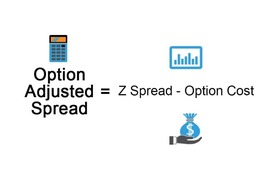
Option-Adjusted Spread
Option-Adjusted Spread (OAS) is the measurement of the yield spread between a fixed-income security and a risk-free benchmark, adjusted to account for the impact of embedded options such as calls, puts, or prepayment features. By factoring in these options, OAS provides a more accurate measure of the bond’s true relative value. For investors, it serves as a critical tool: a wider OAS indicates higher compensation for taking on risk (potential undervaluation), while a narrower OAS suggests lower compensation (potential overvaluation). This makes OAS especially important in evaluating securities with uncertain cash flows, including mortgage-backed securities, callable corporate bonds, and other structured products.
An Option-Adjusted Spread (OAS) is a fixed-income metric that measures the yield spread of a bond relative to a risk-free benchmark, adjusted for the impact of embedded options.
Unlike traditional spread measures, OAS accounts for the uncertainty created by options such as calls, puts, or prepayment features, making it a more accurate way to assess bond valuation and risk-adjusted returns.
A wider OAS indicates that investors are being compensated more for taking on risk (potential undervaluation), while a narrower OAS suggests less compensation (potential overvaluation).
OAS is most commonly applied in analyzing mortgage-backed securities (MBS), callable corporate bonds, and other fixed-income securities with complex or uncertain cash flows.
HOW OAS WORKS
Compare to Treasuries
Start with the bond’s yield versus the Treasury yield curve (the risk-free benchmark).
For plain vanilla bonds, cash flows are fixed. For callable, puttable, or MBS bonds, cash flows vary with interest rates and option exercise.
Simulate Scenarios
Use tools like binomial interest rate trees or Monte Carlo simulations to model interest rate paths and cash flow timing.
Strip Out Options
Adjust the spread by removing the effect of embedded options, isolating the “pure spread” the bond offers over Treasuries.
WHY OAS MATTERS
True Relative Value
Unlike nominal or Z-spreads, OAS accounts for embedded options, enabling fair comparison across callable vs. non-callable bonds.
Risk Assessment
Higher OAS values compensate investors for risks like credit, liquidity, and structure; extremely high OAS may signal market stress or default risk.
Since homeowners can prepay, MBS cash flows are uncertain. OAS modeling helps investors judge their real attractiveness.
Callable Bonds
OAS evaluates whether a bond’s yield is adequate once call risk (issuer refinancing when rates fall) is properly factored in.